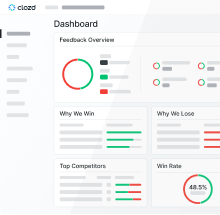In today's crowded marketplace, gaining a clear understanding of the customer journey is vital for any organization striving to thrive and stand out. Customer feedback serves as the compass that guides this journey, providing essential insights that can help create memorable customer experiences and fuel organizational growth. But when should you ask for feedback—and why is collecting these insights so impactful? In this guide, we'll dive deeply into the significance of customer feedback, outlining optimal timing for gathering input and exploring how these insights can be used to drive meaningful business results.
What is Customer Feedback?
Customer feedback encompasses the information, opinions, and observations shared by individuals after interacting with a product, service, or brand. This can come in many forms: insights gathered through surveys, one-on-one interviews, spontaneous remarks on social media, ratings and reviews, and direct conversations with customer support. This feedback acts as an invaluable resource, enabling organizations to gauge how well their offerings meet expectations, spot potential challenges, and continuously improve service delivery.
Effective gathering and analysis of feedback empower businesses to see their offerings through the eyes of their customers—uncovering opportunities to refine processes, enhance offerings, and strengthen relationships. Whether positive or critical, each touchpoint of feedback provides organizations with an opportunity to address unmet needs and exceed customer expectations.
The Importance of Customer Feedback in the Customer Journey
Customer feedback is foundational for multiple reasons:
- Enhancing Customer Experience (CX): Authentic input allows companies to understand customer perceptions, pinpoint strengths, and identify areas needing improvement. With these insights, businesses can take direct and immediate action to refine the customer journey.
- Driving Customer Satisfaction and Loyalty: Proactively addressing issues and implementing improvements demonstrates that customer opinions are valued, paving the way to greater satisfaction and long-lasting loyalty.
- Informing Business Strategy: Feedback reveals trends in customer needs, shifting preferences, and pain points. These insights are instrumental for guiding organizational strategies, refining product development, and shaping marketing campaigns.
- Mitigating Churn: Regular feedback collection helps uncover early warning signs of dissatisfaction, allowing teams to act swiftly and retain valuable customers.
- Creating Brand Advocates: When feedback is acted upon, customers feel heard and are more likely to recommend your brand—contributing to positive word-of-mouth and organic growth.
When to Collect Customer Feedback
The value of customer feedback depends not only on what you ask but also on when you ask it. Strategic timing unlocks the most meaningful and actionable insights. Consider collecting feedback at the following touchpoints in the customer journey:
Collecting customer feedback at various key moments throughout the customer journey is essential for building a customer-centric mindset and uncovering actionable insights. At the Awareness Stage, capturing feedback from potential customers who are just discovering your brand provides a window into which marketing tactics are generating interest, what messaging resonates most, and how prospects perceive your value proposition before direct connections are made. Therefore, using methods like website pop-up questions, quick landing page polls, and monitoring engagement metrics across your digital channels allows you to gather first impressions with minimal friction for the user.
Consideration Stage
As individuals enter the Consideration Stage, feedback becomes a critical tool for understanding the factors that influence their evaluation and comparison of your offerings against competitors. Deploying targeted surveys, soliciting online reviews, and reaching out after content downloads or product demos can reveal what drives decision-making and which concerns or pain points might create obstacles to conversion. These insights not only help refine your positioning but also surface opportunities to improve your content or demo experience.
Purchase Stage
At the Purchase Stage, collecting immediate input after a transaction ensures you capture genuine, real-time feedback about the purchasing process. Quick follow-up emails, post-checkout surveys, or SMS requests help you spot any friction points or areas for improvement while the experience is still top-of-mind for the customer, thus enabling you to swiftly address issues and reinforce a positive transactional experience.
Onboarding Stage
During the Onboarding Stage, soliciting feedback is invaluable in refining materials, clarifying instructions, and making certain that new users feel confident and supported as they begin their journey with your product or service. Tools such as onboarding-specific surveys, in-app feedback forms, and tracking customer support inquiries can surface common confusion points or areas where customers may need more guidance—therefore, allowing you to improve the time-to-value and build a foundation for long-term engagement.
Retention Stage
As customers proceed to the Retention Stage, the focus shifts to sustaining and deepening engagement. Regular feedback at this point—through loyalty program assessments, periodic satisfaction and NPS surveys, along with check-ins by account managers—helps you pinpoint drivers of long-term satisfaction and proactively address any new needs or friction before they escalate. This approach directly impacts customer retention, lifetime value, and overall customer health.
Advocacy Stage
Finally, at the Advocacy Stage, enthusiastic promoters offer some of the richest insights into what sets your brand apart. Inviting testimonials via email, encouraging user-generated content on social media, and conducting in-depth interviews with devoted advocates enables you to understand the motivations behind their loyalty and gather authentic stories that can be leveraged for brand-building and further growth. Consequently, mastering feedback collection at each of these stages turns the customer journey into a dynamic engine for continuous improvement and sustainable business success.
The Power of Live and Flexible Asynchronous Interviews
Traditional methods such as surveys provide useful quantitative data, but to truly discover the intricacies of customer perspectives, organizations should look beyond basic questionnaires. Live and flexible asynchronous interviews offer an opportunity to hold in-depth, tailored conversations—either in real time or at the customer’s convenience.
Such approaches encourage open dialogue, enabling participants to explain their thoughts, elaborate on challenges, and provide context that might be missed in standard survey responses. Asynchronous interviews, in particular, provide flexibility for both participants and organizations, making it easier to reach busy professionals or global customers in different time zones. The insights gathered from these conversations can uncover unmet needs, emotional drivers, and innovative ideas for improvement, contributing to richer understanding and smarter business decisions.
Best Practices for Collecting Customer Feedback
To harness optimal value from your feedback processes, keep these methods in mind:
- Be Clear and Concise: Formulate questions in straightforward, accessible language to encourage honest participation and meaningful responses.
- Show Personality: Interact with customers in a way that's consistent with your brand's distinct character, making each engagement relatable and memorable.
- Be Genuine: Practice authenticity—ask open-ended questions and welcome constructive criticism to demonstrate you are truly invested in improvement.
- Use Active Voice: Communicate dynamically to build rapport and keep your messaging lively and engaging.
- Act on Feedback: Close the loop by thanking customers, sharing what you’ve learned, and outlining concrete steps being taken based on their input.
- Respect Privacy and Time: Explain how feedback will be used and be considerate of respondents’ time, keeping interactions as efficient as possible.
Conclusion
Mastering the timing and motivation for collecting customer feedback is a cornerstone of delivering remarkable customer journeys and achieving sustained growth. By thoughtfully seeking input at every significant stage, organizations gain a 360-degree view of customer perceptions and can act quickly to address needs, resolve issues, and nurture loyalty. Harnessing immersive methods such as live and flexible asynchronous interviews adds further depth and nuance to your insights, empowering you to create more attentive, proactive, and memorable customer experiences. When feedback becomes a central driver in decision-making, both customers and organizations benefit—fueling innovation, growth, and lasting success.











.svg)












.svg)

.svg)




